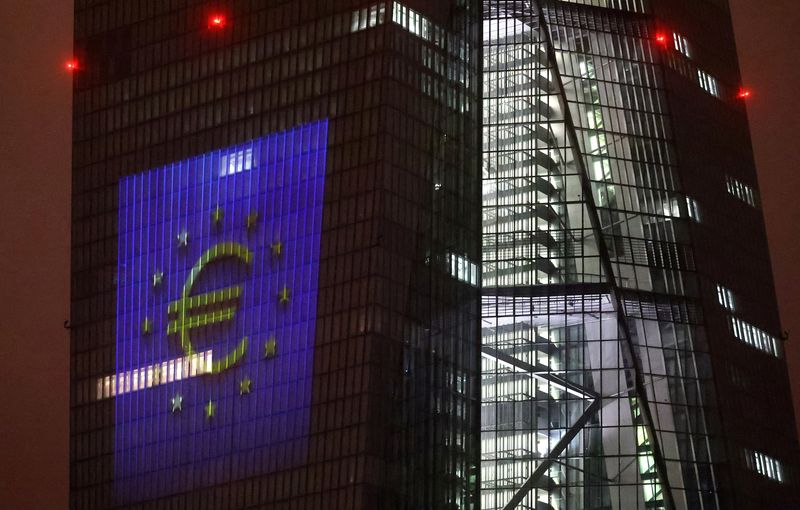By Geoffrey Smith
Investing.com -- The European Central Bank meets to set out an exit course from a nine-year period of negative interest rates. Natural gas prices go haywire after a fire knocks a Texan LNG export terminal offline. Chinese regulators are looking at allowing Ant Group to go public after all, while Spirit Airlines postpones a shareholder vote on its proposed merger with Frontier. And oil prices come off their highs after news of a fresh precautionary lockdown in a part of Shanghai. Here's what you need to know in financial markets on Thursday, 9th June.
1. ECB charts a course out of negative rates
The European Central Bank meets with the unenviable task of having to rein in rampant inflation without killing an economic recovery that is looking increasingly fragile since Russia’s invasion of Ukraine.
Previous guidance suggests that the Frankfurt-based central bank will formally stop its net asset purchases as of the end of this month, paving the way for two 25 basis point increases in its key rates at the next two meetings in July and September.
President Christine Lagarde will also have to tread carefully at her press conference in talking about possible steps to keep sovereign bond spreads within acceptable limits as the bank tightens its policy. Its previous programs to contain spreads have all had the effect of adding liquidity to the financial system – the opposite of what the current state of inflation demands.
2. Gas prices skyrocket in Europe, slump in U.S. after LNG terminal fire
Natural Gas prices fluctuated wildly after a fire at a LNG export terminal in Texas.
Prices in the U.K. and continental Europe surged as a crucial alternative to Russian pipeline gas appeared to be taken offline for at least three weeks.
By contrast, Henry Hub prices extended their Wednesday losses in the overnight session on the prospect that more gas will be ‘trapped’ in the U.S. market, increasing domestic supply.
European LNG demand has been a major factor behind the rally in natgas futures in the last three months, along with the reluctance of shale oil producers to produce more oil (a process which also generates associated natural gas).
3. Stocks drift ahead of jobless claims data; Spirit merger in focus
U.S. stocks are set to open cautiously higher, drifting amid an absence of major economic and corporate news flow.
By 6:15 AM ET (1015 GMT), Dow Jones futures were up 82 points, or 0.3%, while S&P 500 futures were also up 0.3%, and Nasdaq 100 futures were up 0.4%. In the bond market, short-dated yields were pushing a little higher, but benchmark 10-year Treasury note yields were flat.
Stocks likely to be in focus later include Spirit Airlines (NYSE:SAVE), which postponed a key shareholder vote, its proposed merger with Frontier Group (NASDAQ:ULCC) on Wednesday in order to give more consideration to JetBlue's (NASDAQ:JBLU) latest rival offer. Also in focus will be Abbott (NYSE:ABT), after fresh disclosures about its knowledge of problems with its baby formula supply chain.
Weekly jobless claims head an otherwise thin data calendar at 8:30 AM ET.
4. Ant Group IPO back on?
The signs of a renaissance in Chinese tech stocks keep on increasing. Bloomberg reported that Beijing is in talks with financial services giant Ant Group to revive its abortive IPO.
Ant’s IPO was the defining moment in a year-long regulatory crackdown against a tech sector whose financial and economic clout had started to worry the Communist Party, and arguably the biggest single catalyst in the startling fall of affiliated Internet platform company Alibaba (NYSE:BABA).
Alibaba ADRs, which had already made substantial gains earlier in the week on signs of leniency by regulators toward other tech companies, rose another 2.6% in premarket, on course for what would be a four-month high.
5. Crude drifts after Shanghai news, U.S. inventory rise
Oil prices drifted but stayed close to recent highs after data from the U.S. government confirmed a surprising rise in inventories of both crude and refined products last week. A renewed precautionary lockdown in parts of Shanghai contributed to the weakness.
By 6:25 AM ET (1025 GMT), U.S. crude futures were down 0.2% at $121.83 a barrel, while Brent crude was down 0.2% at $123.35 a barrel.
Downside for both blends looks limited as long as inventories remain at their current low level. U.S. commercial inventories would only cover 58 days’ consumption based on the latest weekly demand figures, compared to 73 days a year ago.
